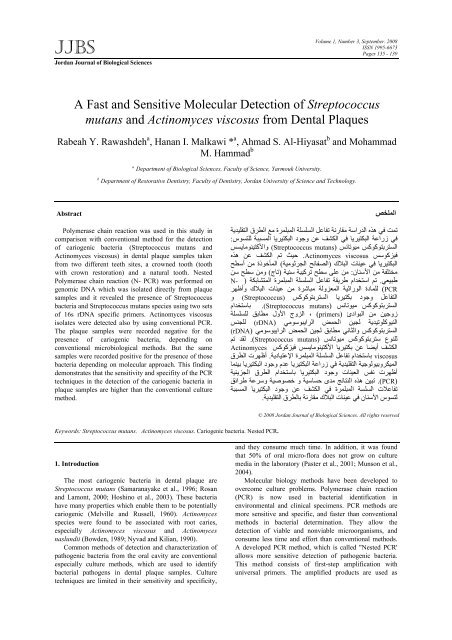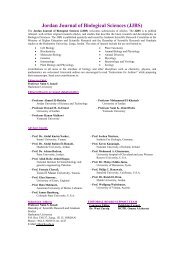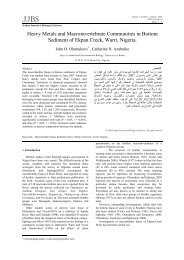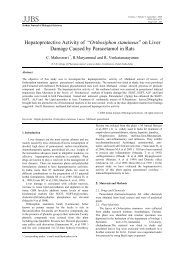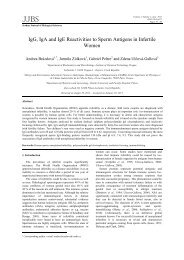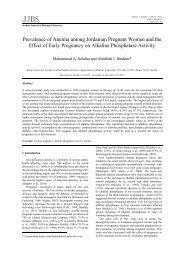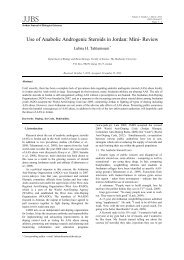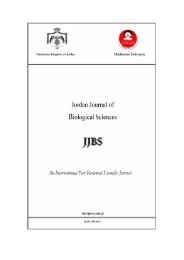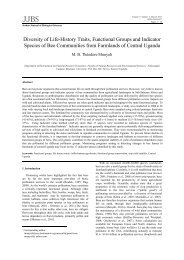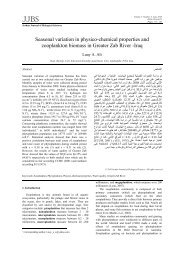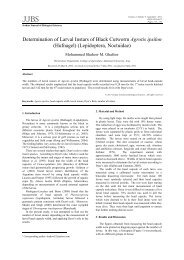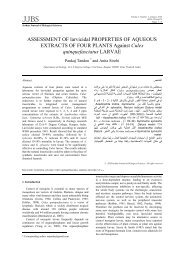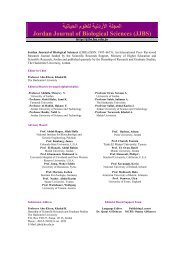A Fast and Sensitive Molecular Detection of Streptococcus mutans ...
A Fast and Sensitive Molecular Detection of Streptococcus mutans ...
A Fast and Sensitive Molecular Detection of Streptococcus mutans ...
You also want an ePaper? Increase the reach of your titles
YUMPU automatically turns print PDFs into web optimized ePapers that Google loves.
JJBS<br />
Jordan Journal <strong>of</strong> Biological Sciences<br />
Volume 1, Number 3, September. 2008<br />
ISSN 1995-6673<br />
Pages 135 - 139<br />
A <strong>Fast</strong> <strong>and</strong> <strong>Sensitive</strong> <strong>Molecular</strong> <strong>Detection</strong> <strong>of</strong> <strong>Streptococcus</strong><br />
<strong>mutans</strong> <strong>and</strong> Actinomyces viscosus from Dental Plaques<br />
Rabeah Y. Rawashdeh a , Hanan I. Malkawi * a , Ahmad S. Al-Hiyasat b <strong>and</strong> Mohammad<br />
M. Hammad b<br />
Abstract<br />
a Department <strong>of</strong> Biological Sciences, Faculty <strong>of</strong> Science, Yarmouk University.<br />
b Department <strong>of</strong> Restorative Dentistry, Faculty <strong>of</strong> Dentistry, Jordan University <strong>of</strong> Science <strong>and</strong> Technology.<br />
ﺺﺨﻠﻤﻟا<br />
Polymerase<br />
chain reaction was used in this study in ﺔﻳﺪﻴﻠﻘﺘﻟا قﺮﻄﻟا ﻊﻣ ةﺮﻤﻠﺒﻤﻟا ﺔﻠﺴﻠﺴﻟا ﻞﻋﺎﻔﺗ ﺔﻧرﺎﻘﻣ ﺔﺳارﺪﻟا ﻩﺬه ﻲﻓ ﺖﻤﺗ<br />
comparison with conventional method for the detection<br />
<strong>of</strong> cariogenic bacteria (<strong>Streptococcus</strong> <strong>mutans</strong> <strong>and</strong><br />
Actinomyces viscosus) in dental plaque samples taken<br />
: سﻮﺴﺘﻠﻟ ﺔﺒﺒﺴﻤﻟا ﺎﻳﺮﻴﺘﻜﺒﻟا دﻮﺟو ﻦﻋ ﻒﺸﻜﻟا ﻲﻓ ﺎﻳﺮﻴﺘﻜﺒﻟا ﺔﻋارز ﻲﻓ<br />
ﺲﺴﻳﺎﻣﻮﻨﻴﺘآﻷاو (<strong>Streptococcus</strong> <strong>mutans</strong>)<br />
ﺲﻧﺎﺗﻮﻴﻣ ﺲآﻮآﻮﺘﺑﺮﺘﺴﻟا<br />
ﻩﺬه ﻦﻋ ﻒﺸﻜﻟا ﻢﺗ ﺚﻴﺣ . Actinomyces viscosus ﺲﺳﻮآﺰﻴﻓ<br />
from two different teeth sites, a crowned tooth (tooth ﺢﻄﺳأ ﻦﻣ ةذﻮﺧﺄﻤﻟا ( ﺔﻴﻣﻮﺛﺮﺠﻟا ﺢﺋﺎﻔﺼﻟا)<br />
كﻼﺒﻟا تﺎﻨﻴﻋ ﻲﻓ ﺎﻳﺮﻴﺘﻜﺒﻟا<br />
with crown restoration) <strong>and</strong> a natural tooth. Nested ﻦﺳ ﺢﻄﺳ ﻦﻣو ( جﺎﺗ)<br />
ﺔﻴﻨﺳ ﺔﺒﻴآﺮﺗ ﺢﻄﺳ ﻰﻠﻋ ﻦﻣ : نﺎﻨﺳﻷا ﻦﻣ ﺔﻔﻠﺘﺨﻣ<br />
Polymerase chain reaction (N- PCR) was performed on N- ) ﺔﻜﺑﺎﺸﺘﻤﻟا ةﺮﻤﻠﺒﻤﻟا ﺔﻠﺴﻠﺴﻟا ﻞﻋﺎﻔﺗ ﺔﻘﻳﺮﻃ ماﺪﺨﺘﺳا ﻢﺗ . ﻲﻌﻴﺒﻃ<br />
genomic DNA which was isolated directly from plaque ﺮﻬﻇأو كﻼﺒﻟا تﺎﻨﻴﻋ ﻦﻣ ةﺮﺷﺎﺒﻣ ﺔﻟوﺰﻌﻤﻟا ﺔﻴﺛارﻮﻟا ةدﺎﻤﻠﻟ ( PCR<br />
samples <strong>and</strong> it revealed the presence <strong>of</strong> <strong>Streptococcus</strong> و (<strong>Streptococcus</strong>) ﺲآﻮآﻮﺘﺑﺮﺘﺴﻟا ﺎﻳﺮﻴﺘﻜﺑ دﻮﺟو ﻞﻋﺎﻔﺘﻟا<br />
bacteria <strong>and</strong> <strong>Streptococcus</strong> <strong>mutans</strong> species using two sets ماﺪﺨﺘﺳﺎﺑ . (<strong>Streptococcus</strong> <strong>mutans</strong>)<br />
ﺲﻧﺎﺗﻮﻴﻣ ﺲآﻮآﻮﺘﺑﺮﺘﺴﻟا <strong>of</strong> 16s rDNA specific primers. Actinomyces viscosus ﺔﻠﺴﻠﺴﻠﻟ ﻖﺑﺎﻄﻣ لوﻷا<br />
جوﺰﻟا ، ( primers)<br />
ئداﻮﺒﻟا ﻦﻣ ﻦﻴﺟوز<br />
isolates were detected also by using conventional PCR. ﺲﻨﺠﻠﻟ (rDNA)<br />
ﻲﻣﻮﺳﻮﺒﻳاﺮﻟا ﺾﻤﺤﻟا ﻦﻴﺠﻟ ﺔﻳﺪﻴﺗﻮﻠآﻮﻴﻨﻟا<br />
The plaque samples were recorded negative for the (rDNA)<br />
ﻲﻣﻮﺳﻮﺒﻳاﺮﻟا ﺾﻤﺤﻟا ﻦﻴﺠﻟ ﻖﺑﺎﻄﻣ ﻲﻧﺎﺜﻟاو ﺲآﻮآﻮﺘﺑﺮﺘﺴﻟا<br />
presence <strong>of</strong> cariogenic bacteria, depending on ﻢﺗ ﺪﻘﻟ .( <strong>Streptococcus</strong> <strong>mutans</strong>)<br />
ﺲﻧﺎﺗﻮﻴﻣ ﺲآﻮآﻮﺘﺑﺮﺘﺳ عﻮﻨﻠﻟ<br />
conventional microbiological methods. But the same Actinomyces ﺲآﻮآﺰﻴﻓ ﺲﺴﻳﺎﻣﻮﻨﻴﺘآﻷا ﺎﻳﺮﻴﺘﻜﺑ ﻦﻋ ﺎﻀﻳأ ﻒﺸﻜﻟا<br />
samples were recorded positive for the presence <strong>of</strong> those قﺮﻄﻟا تﺮﻬﻇأ . ﺔﻳدﺎﻴﺘﻋﻹا ةﺮﻤﻠﺒﻤﻟا ﺔﻠﺴﻠﺴﻟا ﻞﻋﺎﻔﺗ<br />
ماﺪﺨﺘﺳﺎﺑ viscosus<br />
bacteria depending on molecular approach. This finding ﺎﻤﻨﻴﺑ ﺎﻳﺮﻴﺘﻜﺒﻟا دﻮﺟو مﺪﻋ ﺎﻳﺮﻴﺘﻜﺒﻟا ﺔﻋارز ﻲﻓ ﺔﻳﺪﻴﻠﻘﺘﻟا ﺔﻴﺟﻮﻟﻮﻴﺑوﺮﻜﻴﻤﻟا<br />
demonstrates that the sensitivity <strong>and</strong> specifity <strong>of</strong> the PCR ﺔﻴﺌﻳﺰﺠﻟا قﺮﻄﻟا ماﺪﺨﺘﺳﺎﺑ ﺎﻳﺮﻴﺘﻜﺒﻟا دﻮﺟو تﺎﻨﻴﻌﻟا ﺲﻔﻧ تﺮﻬﻇأ<br />
techniques in the detection <strong>of</strong> the cariogenic bacteria in ﻖﺋاﺮﻃ ﺔﻋﺮﺳو ﺔﻴﺻﻮﺼﺧ و ﺔﻴﺳﺎﺴﺣ ىﺪﻣ ﺞﺋﺎﺘﻨﻟا ﻩﺬه ﻦﻴﺒﺗ .( PCR)<br />
plaque samples are higher than the conventional culture ﺔﺒﺒﺴﻤﻟا ﺎﻳﺮﻴﺘﻜﺒﻟا دﻮﺟو ﻦﻋ ﻒﺸﻜﻟا ﻲﻓ ةﺮﻤﻠﺒﻤﻟا ﺔﺴﻠﺴﻟا تﻼﻋﺎﻔﺗ<br />
method.<br />
. ﺔﻳﺪﻴﻠﻘﺘﻟا قﺮﻄﻟﺎﺑ ﺔﻧرﺎﻘﻣ كﻼﺒﻟا تﺎﻨﻴﻋ ﻲﻓ نﺎﻨﺳﻷا سﻮﺴﺘﻟ<br />
Keywords: <strong>Streptococcus</strong> <strong>mutans</strong>. Actinomyces<br />
viscosus. Cariogenic bacteria. Nested PCR.<br />
1. Introduction<br />
The most cariogenic bacteria in dental plaque are<br />
<strong>Streptococcus</strong><br />
<strong>mutans</strong> (Samaranayake et al., 1996; Rosan<br />
<strong>and</strong> Lamont, 2000; Hoshino et al., 2003). These bacteria<br />
have many properties which enable them to be potentially<br />
cariogenic (Melville <strong>and</strong> Russell, 1960). Actinomyces<br />
species were found to be associated with root caries,<br />
especially Actinomyces viscosus <strong>and</strong> Actinomyces<br />
naslundii (Bowden, 1989; Nyvad <strong>and</strong> Kilian, 1990).<br />
Common methods <strong>of</strong> detection <strong>and</strong> characterization<br />
<strong>of</strong><br />
pathogenic<br />
bacteria from the oral cavity are conventional<br />
especially culture methods, which are used to identify<br />
bacterial pathogens in dental plaque samples. Culture<br />
techniques are limited in their sensitivity <strong>and</strong> specificity,<br />
© 2008 Jordan Journal <strong>of</strong> Biological Sciences. All rights reserved<br />
<strong>and</strong> they consume much time. In addition, it was found<br />
that 50% <strong>of</strong> oral micro-flora does not grow on culture<br />
media in the laboratory (Paster et al., 2001; Munson et al.,<br />
2004).<br />
<strong>Molecular</strong> biology methods have been developed to<br />
overcome<br />
culture problems. Polymerase chain reaction<br />
(PCR)<br />
is now used in bacterial identification in<br />
environmental <strong>and</strong> clinical specimens. PCR methods are<br />
more sensitive <strong>and</strong> specific, <strong>and</strong> faster than conventional<br />
methods in bacterial determination. They allow the<br />
detection <strong>of</strong> viable <strong>and</strong> nonviable microorganisms, <strong>and</strong><br />
consume less time <strong>and</strong> effort than conventional methods.<br />
A developed PCR method, which is called "Nested PCR'<br />
allows more sensitive detection <strong>of</strong> pathogenic bacteria.<br />
This method consists <strong>of</strong> first-step amplification with<br />
universal primers. The amplified products are used as
136<br />
2. Materials <strong>and</strong> Methods<br />
© 2008 Jordan Journal <strong>of</strong> Biological Sciences. All rights reserved - Volume 1, Number 3<br />
template in second-step amplification, where species<br />
specific primers are used (Sato et al., 2003).<br />
This study is the first to be done in Jordan using<br />
molecular<br />
methods for the detection <strong>of</strong> the most cariogenic<br />
bacteria in the oral cavity obtained from dental plaque<br />
from different teeth sites.<br />
The aim <strong>of</strong> this study is<br />
to detect the most cariogenic<br />
bacteria<br />
in plaque samples taken from different teeth sites<br />
by using polymerase chain reaction (PCR) method. PCR<br />
was performed for specific detection Actinomyces<br />
viscosus. Nested PCR was used to specifically detect<br />
<strong>Streptococcus</strong> <strong>mutans</strong> species. The approache <strong>of</strong> this study<br />
can be used in future research for detecting the effect <strong>of</strong><br />
certain dental restorations, or materials, on the bacterial<br />
composition <strong>of</strong> dental plaque.<br />
2.1. Subjects <strong>and</strong> Plaque Sampling<br />
The study consisted <strong>of</strong> four plaque<br />
samples taken from<br />
one<br />
person who had a metal ceramic crown restoration <strong>and</strong><br />
a natural tooth in the closet proximity to the crown site.<br />
The study protocol was approved by the Committee <strong>of</strong><br />
Search on Human at Jordan University <strong>of</strong> Science <strong>and</strong><br />
Technology. The subject was a patient <strong>of</strong> Dental Teaching<br />
Center.<br />
Dental<br />
plaque samples were collected by using sterile<br />
curettes<br />
(Gracey Curettes). Supragingival plaque was<br />
taken first from the crown site, <strong>and</strong> then was taken from<br />
the subgingival plaque. The same procedure was applied to<br />
the plaque samples obtained from the natural tooth. The<br />
plaque samples were suspended in 1 ml <strong>of</strong> sterile<br />
Phosphate buffer saline PBS (0.12 M NaCl, 0.01 M<br />
Na2HPO4, 5mM KH2PO4 [pH 7.5]). The samples were<br />
transported on icebox to the laboratory.<br />
2.2. <strong>Detection</strong> <strong>of</strong> Cariogenic Bacteria by<br />
Methods<br />
Cultivation<br />
Plaque samples were dispersed by vortexing for 30s<br />
with<br />
glass beads (diameter 4 mm), <strong>and</strong> samples were<br />
diluted into different decimal serial dilutions in phosphate<br />
buffer saline (pH 7.5). The appropriate dilutions <strong>of</strong> each<br />
sample was plated on the following selective media: Mitis<br />
salivarius agar (MSA) supplemented with 0.2 U/ml<br />
bacitracin <strong>and</strong> 5% sucrose <strong>and</strong> Cadmium Flouride<br />
Acriflavine Tellurite (CFAT) medium supplemented with<br />
5% human blood for the culture <strong>of</strong> <strong>Streptococcus</strong> <strong>mutans</strong><br />
<strong>and</strong> Actinomyces species respectively. The plates were<br />
incubated at 37 °C for three days in an anaerobic jar with<br />
CO2 gas generating kit. To confirm the presence <strong>of</strong><br />
<strong>Streptococcus</strong> <strong>mutans</strong>, the bacterial isolates grown on<br />
MSBS were subjected to certain biochemical tests (Sneath<br />
et al., 1986). For the identification <strong>of</strong> the bacterial isolates,<br />
which were grown on CFAT media, the RapID ANA II kit<br />
(Remel Compny. USA) biochemical kit was used<br />
according to the manufacture’s instructions.<br />
2.3. Extraction <strong>of</strong> The Genomic DNA from <strong>Streptococcus</strong><br />
Isolates<br />
Extraction <strong>of</strong> genomic DNA from bacterial colonies<br />
(local isolates in our laboratory), grown on MSA<br />
supplemented with bacitracin <strong>and</strong> sucrose was done as<br />
following:<br />
one colony from each pure bacterial isolate was<br />
inoculated<br />
into 10 ml <strong>of</strong> Trypticase soya broth <strong>and</strong><br />
incubated for 24 hours at 37°C. 1 ml from each <strong>of</strong> the<br />
trypticase broth <strong>of</strong> the 24 hours broth was transferred to a<br />
new sterile eppendorf tube <strong>and</strong> the bacterial cells were<br />
harvested by centrifugation at 8000 xg for 15 minutes. The<br />
resulted pellet was digested by addition <strong>of</strong> 500 µl <strong>of</strong> lysis<br />
buffer (50 mM tris buffer, 1 mM EDTA, 0.5% Tween 20,<br />
<strong>and</strong> proteinase K (200µg/ml). pH 8) <strong>and</strong> then incubation at<br />
55°C for 2 hours. Heating at 90 °C for 5 minutes was done<br />
for the inactivation <strong>of</strong> proteinase K. The DNA was<br />
precipitated by addition <strong>of</strong> an equal volume <strong>of</strong> cold<br />
isopropanol <strong>and</strong> incubated in freezer for 20 minutes. The<br />
pellet was washed with 70% ethanol <strong>and</strong> then rehydrated<br />
by addition <strong>of</strong> 35-50µl TE buffer (10 mM Tris- HCl, <strong>and</strong> 1<br />
mM EDTA) (pH 8). This DNA was subjected to N-PCR<br />
reaction for amplification <strong>of</strong> 16s rDNA specific to the<br />
genus <strong>Streptococcus</strong> <strong>and</strong> species <strong>Streptococcus</strong> <strong>mutans</strong>.<br />
2.4. Extraction <strong>of</strong> Total Genomic DNA Directly from<br />
Plaque Samples.<br />
The total genomic DNA was isolated from plaque<br />
samples according to Paster et. al. (2001) with few<br />
modifications as follows: 100 µl <strong>of</strong> plaque sample was<br />
transferred to a new<br />
sterile eppendorf tube where 100 µl <strong>of</strong><br />
the lysis buffer was added (50 mM tris buffer, 1 mM<br />
EDTA, 0.5% Tween 20, <strong>and</strong> proteinase K (200µg/ml). pH<br />
8), then incubation at 55-60 ºC was done for 1.5 hour.<br />
Inactivation <strong>of</strong> proteinase K was done at 90 ºC for 5<br />
minutes. After that, samples were cooled on ice for few<br />
minutes <strong>and</strong> the DNA was precipitated by the addition <strong>of</strong><br />
an equal volume <strong>of</strong> ice-cold isopropanol <strong>and</strong> incubated at<br />
refrigerator overnight. The DNA pellet was washed with<br />
70% ethanol, <strong>and</strong> was then rehydrated in 20- 30 µl TE<br />
buffer (10 mM Tris- HCl, <strong>and</strong> 1 mM EDTA) (pH 8).<br />
2.5. Polymerase Chain Reaction (PCR)<br />
Genomic DNA <strong>of</strong> 4 plaque samples that belong to one<br />
person was subjected to PCR reactions in order to detect<br />
the presence <strong>of</strong> Actinomyces viscosus. A Nested PCR (N-<br />
PCR) reaction was performed to detect the presence<br />
<strong>of</strong><br />
<strong>mutans</strong><br />
Streptococci. The first (N- PCR) was conducted to<br />
detect genus Streptococci, <strong>and</strong> the second (N- PCR)<br />
detected <strong>Streptococcus</strong> <strong>mutans</strong>.<br />
For each PCR reaction, a negative control reaction was<br />
performed where no DNA template was added. All PCR<br />
reactions were performed in a Perkin Elmer DNA thermal<br />
cycler (Perkin Elmer 480). All PCR products were kept at<br />
4 º C until analyzed.<br />
2.6. <strong>Detection</strong> <strong>of</strong> The Presence <strong>of</strong> <strong>Streptococcus</strong> Mutans<br />
Using Nested PCR Polymerase Chain Reaction, using<br />
primer pair specific to 16S rDNA specific to<br />
<strong>Streptococcus</strong>, was performed according to Sato et al.<br />
(2003) to detect <strong>Streptococcus</strong>. The target sequence <strong>of</strong> 16S<br />
rDNA was amplified by using PCR mixture (total volume<br />
25 µl) containing 3mM MgCl2, 0.4 mM dNTPs, 5U <strong>of</strong> Taq<br />
DNA polymerase, 1µl <strong>of</strong> each primer (5uM) (Table 1), 2.5<br />
µl <strong>of</strong> 10x PCR buffer, <strong>and</strong> 1 µl <strong>of</strong> template DNA (20 ng).<br />
The PCR program consisted <strong>of</strong> initial denaturation at 95<br />
ºC for 15 min, <strong>and</strong> 35 cycles involving denaturation at 94<br />
ºC for 1 min, <strong>and</strong> annealing at 55 ºC for 1 min, <strong>and</strong>
© 2008 Jordan Journal <strong>of</strong> Biological Sciences. All rights reserved - Volume 1, Number 3 137<br />
extension at 72 ºC for 1.5 min followed by a final extension<br />
at 72 ºC for 10 min. All reaction mixtures were held at<br />
4°C.<br />
Table 1: Primers that were used for the amplification <strong>of</strong> oral<br />
bacteria<br />
Primer set Sequence 5'→3' bp a<br />
Reference<br />
Streptococci 8UA (F) AGA GTT TGA 1505 Sato et al.<br />
species<br />
TCM TGG CTC<br />
2003<br />
AG<br />
1492 (R) TAC GGY TAC<br />
CTT GTT ACG<br />
ACT T<br />
Streptococc Sm1 (F) GGTCAGGAAAG 282<br />
us<br />
TCTGGAGTAAA<br />
<strong>mutans</strong><br />
AGGCT A<br />
Sm2 (R) GCG GTA GCT<br />
CCG GCA CTA<br />
Actinomyces A.vis (F) ATG TGG GTC 96 Suzuki et<br />
viscosuss<br />
TGA CCT GCT<br />
A.vis CAA AGT CGA<br />
al. 2004<br />
(R) TCA CGC TCC G<br />
a<br />
: Size <strong>of</strong> the amplified product bp<br />
The second nested PCR reaction was done for<br />
the<br />
detection <strong>of</strong> <strong>Streptococcus</strong><br />
<strong>mutans</strong><br />
by using species<br />
specific primers based<br />
on the 16S rDNA, Sato. et al.<br />
(2003). Briefly: The target sequence<br />
<strong>of</strong> 16S rDNA was<br />
amplified<br />
by using PCR mixture (total volume 25 µl)<br />
containing: 3mM MgCl2, 0.4 mM dNTPs, 5U <strong>of</strong> Taq DNA<br />
polymerase, 1µl <strong>of</strong> each primer (5µM) (Table 1), 2.5 µl <strong>of</strong><br />
10x PCR buffer, <strong>and</strong> 1 µl <strong>of</strong> template DNA (20 ng). The<br />
PCR program is isentical to the one used in the detection<br />
<strong>of</strong> <strong>Streptococcus</strong> genus in the first reaction.<br />
2.7. PCR <strong>Detection</strong> <strong>of</strong> The Presence <strong>of</strong> Actinomyces<br />
Viscosus by Using Primer Pair Specific to The Species<br />
Polymerase Chain Reaction for Actinomyces viscosus<br />
using species specific primers to each species was<br />
performed according to Suzuki et al. (2004). The target<br />
sequence <strong>of</strong> 16S rDNA was amplified using PCR mixture<br />
(total<br />
volume 25 µl) containing: 1.5 mM MgCl2, 0.25 mM<br />
dNTPs, 5U <strong>of</strong> Taq DNA polymerase, <strong>and</strong> each <strong>of</strong> the<br />
primer added at a concentration <strong>of</strong> 0.2µM (Table 1), 2.5 µl<br />
<strong>of</strong> 10x PCR buffer, <strong>and</strong> 1 µl <strong>of</strong> template DNA (20 ng). The<br />
PCR program had initial denaturation at 95 ºC for 15 min,<br />
<strong>and</strong> 35 cycles involving denaturation at 94 ºC for 1 min,<br />
<strong>and</strong> annealing at 55 ºC for 1 min, with extension at 72 ºC<br />
for 1.5 min followed by a final extension at 72 ºC for 10<br />
min. All PCR products were held at 4°C.<br />
2.8. Gel Electrophoresis <strong>and</strong> Photography<br />
The PCR amplified products were separated in ultrapure<br />
agarose gels dissolved in 1X TBE buffer<br />
(0.89 M Tris<br />
Base, 0.89 M Boric Acid, 20 mM EDTA) ( pH 8.3). 1.5 %<br />
w/v gel was used for separation <strong>of</strong> amplified PCR products<br />
for <strong>Streptococcus</strong> detection. And 3% w/v gel was used for<br />
the separation <strong>of</strong> PCR b<strong>and</strong>s <strong>of</strong> Actinomyces amplification<br />
products. 5 µl <strong>of</strong> PCR product was mixed with 2 µl <strong>of</strong> 6x<br />
loading dye <strong>and</strong> then loaded into the well <strong>of</strong> the gel. 1 Kilo<br />
base pair (Kbp) <strong>and</strong> 100 base pair (bp) markers were<br />
included in the gel. PCR products were separated through<br />
the gel at an electric current <strong>of</strong> 90 V for 1 hour by using<br />
horizontal gel electrophoresis apparatus (Sigma Chemicals<br />
Co. USA). Gels were stained with ethidium bromide<br />
(0.5µg/ml) <strong>and</strong> visualized on a UV transilluminator by<br />
using BioDocAnalyze (Biometra, Germany).<br />
3. Results<br />
3.1. <strong>Detection</strong> <strong>of</strong> Cariogenic Bacteria by Cultivation<br />
Methods<br />
All cultivated plaque samples were recorded 'negative'<br />
(no bacterial growth) regarding the detection <strong>of</strong><br />
<strong>Streptococcus</strong><br />
<strong>mutans</strong> <strong>and</strong> Actinomyces species.<br />
Figure 1: Agarose gel electrophoresis <strong>of</strong> the total genomic DNA<br />
isolated from four plaque samples (Lane 2 to Lane 5). Lane 1;<br />
molecular weight marker (1K bp ladder). Lane 2; the<br />
supragingival plaque <strong>of</strong> natural site, Lane 3; the supgingival<br />
plaque <strong>of</strong> the natural site, Lane 4; the supragingival plaque from<br />
crown site, Lane 5; the subgingival plaque from the crown site.<br />
3.2. Total Genomic DNA Extraction Directly from Plaque<br />
Samples<br />
The total Genomic DNA was isolated as described<br />
previously in materials <strong>and</strong> methods from four plaque<br />
samples ( Figure 1), <strong>and</strong> revealed good quality <strong>and</strong> quantity<br />
<strong>of</strong> genomic DNA.<br />
3.3. <strong>Detection</strong> <strong>of</strong> the presence <strong>of</strong> Streptococci <strong>mutans</strong><br />
using Nested PCR<br />
Total genomic DNA, which was isolated directly from<br />
plaque samples, was subjected to N-PCR reactions. The<br />
detection <strong>of</strong> the genus<br />
Streptococci was performed by<br />
using<br />
primer pair specific to 16s rDNA <strong>of</strong> the genus<br />
Streptococci. The positive amplified PCR product (1505<br />
bp size), representing <strong>Streptococcus</strong> genus, was detected in<br />
all the 4 samples (Fig. 2). In the second reaction, the<br />
detection <strong>of</strong> the Streptococci <strong>mutans</strong> was done by using<br />
16s rDNA primer pair specific to the species <strong>Streptococcus</strong><br />
<strong>mutans</strong>. The species <strong>Streptococcus</strong> <strong>mutans</strong> was detected in<br />
all, four, samples. (Fig. 3) represents the presence <strong>of</strong> the<br />
amplified PCR product (282 bp).
138<br />
© 2008 Jordan Journal <strong>of</strong> Biological Sciences. All rights reserved - Volume 1, Number 3<br />
Figure 2: Agarose gel electrophoresis <strong>of</strong> PCR amplified products<br />
for 16s rDNA specific to <strong>Streptococcus</strong> genus for four plaque<br />
samples. The amplified b<strong>and</strong> is 1505 bp. Lane M; molecular<br />
weight marker (1K bp ladder). Lane 1: positive control (PCR<br />
amplified product from genomic DNA isolated from the bacterial<br />
species <strong>Streptococcus</strong> <strong>mutans</strong>), (Lanes 2 <strong>and</strong> 3: represents plaques<br />
from natural tooth, (Lanes 4 <strong>and</strong> 5): represents plaques from<br />
crown tooth. (Lanes 2 <strong>and</strong> 4): represents the supragingival plaque,<br />
(Lanes 3 <strong>and</strong> 5): represents the subgingival plaque. Lane 6:<br />
negative control.<br />
3.4. PCR detection <strong>of</strong> the presence <strong>of</strong> Actinomyces<br />
viscosus by using primer pair specific to these species<br />
PCR detection <strong>of</strong> the presence <strong>of</strong> species Actinomyces<br />
viscosus using primer pair specific for this species (Table<br />
1) resulted in an amplified product <strong>of</strong> 96 bp which was<br />
detected in all four samples (Fig. 4). All these samples<br />
were recorded negative <strong>of</strong> Actinomyces species by using<br />
the cultivation on CFAT medium.<br />
4. Discussion<br />
In this study four plaque samples, which belong to one<br />
person, were included in the study. The plaque samples,<br />
which were obtained from crown site, have zero count <strong>of</strong><br />
<strong>Streptococcus</strong> <strong>mutans</strong> <strong>and</strong> <strong>of</strong> Actinomyces viscosus.<br />
However, PCR methodology was able to positively detect<br />
<strong>Streptococcus</strong> <strong>mutans</strong> <strong>and</strong> Actinomyces viscosus in all<br />
these samples. Wade (2002) indicated that many bacteria<br />
escaped the conventional culture techniques for detection<br />
either because they are unproductive, or because there are<br />
not distinguishable from similar species by observable<br />
phenotypic characteristics. In this study, <strong>Streptococcus</strong><br />
<strong>mutans</strong> <strong>and</strong> Actinomyces viscosus were not detected in<br />
previous samples based on the conventional culture<br />
method. This could be attributable to their presence in low<br />
proportions in the samples, <strong>and</strong>/or the culture medium was<br />
not sensitive enough for the detection <strong>of</strong> the low levels <strong>of</strong><br />
those bacterial species. This confirms <strong>and</strong> proves that PCR<br />
is more sensitive than conventional culture method.<br />
The results <strong>of</strong> this study confirm the disadvantages <strong>of</strong><br />
conventional method such as poor specificity <strong>and</strong><br />
sensitivity; detection <strong>of</strong> only viable culturable bacteria -<br />
<strong>and</strong> that they are time consuming <strong>and</strong> laborious.<br />
Figure 3: PCR detection <strong>of</strong> the species <strong>Streptococcus</strong> <strong>mutans</strong> in<br />
four plaque samples. Lane M; molecular weight marker (100 bp<br />
ladder), Lane 1: positive control, (Lanes 2 <strong>and</strong> 3): represents<br />
plaque samples from natural tooth, (Lanes 4 <strong>and</strong> 5): represents<br />
plaque samples from crown tooth, (Lanes 2 <strong>and</strong> 4): represents<br />
supragingival plaque samples, (Lanes 3 <strong>and</strong> 5): represents<br />
subgingival plaque samples. The size <strong>of</strong> amplified product is 282<br />
bp. Lane 6: negative control.<br />
Figure 4: PCR detection <strong>of</strong> the species Actinomyces viscosus in<br />
four plaque samples. Lane M; molecular weight marker (100 bp<br />
ladder), (Lanes 1 <strong>and</strong> 2): represents plaque samples from natural<br />
tooth, (Lanes 3 <strong>and</strong> 4): represents plaque samples from crown<br />
tooth, (Lanes 1 <strong>and</strong> 3): represents supragingival plaque samples,<br />
(Lanes 2 <strong>and</strong> 4): represents subgingival plaque samples. The size<br />
<strong>of</strong> amplified product is 282 bp. Lane 5: negative control.<br />
On the other h<strong>and</strong>, PCR methodology provides a more<br />
sensitive mean <strong>of</strong> detection <strong>of</strong> putative bacterial species<br />
even non-culturable bacteria if compared with<br />
conventional culture techniques. Also it is able to detect<br />
low numbers <strong>of</strong> bacterial species, being quick <strong>and</strong><br />
relatively simple to perform. Moreover, a PCR assay has<br />
been found to be suitable for the specific detection <strong>and</strong><br />
identification <strong>of</strong> human cariogenic bacteria like<br />
<strong>Streptococcus</strong> <strong>mutans</strong> (Sato et al., 2003). This study<br />
detected both <strong>Streptococcus</strong> <strong>mutans</strong> <strong>and</strong> Actinomyces<br />
species to be the most serious human cariogenic bacteria.<br />
This research provides protocols that are potentially<br />
considered a cornerstone <strong>of</strong> the oral microbiological<br />
research that can be conducted in order to investigate the<br />
composition <strong>of</strong> dental plaque with many stressful factors,<br />
for instance, presence <strong>of</strong> dental materials.
5. Conclusion<br />
© 2008 Jordan Journal <strong>of</strong> Biological Sciences. All rights reserved - Volume 1, Number 3 139<br />
With the methods <strong>of</strong> this study, the following<br />
conclusions could be drawn: PCR molecular approach was<br />
very sensitive, <strong>and</strong> it was specific <strong>and</strong> rapid in detecting<br />
<strong>and</strong> identifying the presences <strong>of</strong> cariogenic bacteria if<br />
compared to conventional culture approach. So it is<br />
recommended, for further research, to utilize PCR<br />
technique as a sensitive <strong>and</strong> specific method for the<br />
detection <strong>and</strong> identification <strong>of</strong> the human cariogenic<br />
bacteria.<br />
Acknowledgment<br />
This study was supported by the Deanship <strong>of</strong> graduate<br />
studies <strong>and</strong> research at Yarmouk University-Jordan, grant<br />
No. 2/2006.<br />
References<br />
Bowden G H W. 1989. Microbiology <strong>of</strong> root surface caries in<br />
humans. Journal <strong>of</strong> Dental Research. 69: 1205-1210.<br />
Hoshino T, Kawaguchi M, Shimizu N, Hoshino N, Ooshima T<br />
<strong>and</strong> Fujiwara T. 2003. PCR detection <strong>and</strong> identification <strong>of</strong> oral<br />
streptococcus in saliva samples using gtf genes. Journal <strong>of</strong><br />
Diagnostic Microbiology <strong>and</strong> Infectious Disease. 48: 195-199.<br />
Melville T H <strong>and</strong> Russell C. 1960. Microbiology for dental<br />
students. 3 rd ed. William Heinemann Medical Books Ltd.<br />
London.<br />
Munson M A, Banerjee A, Watson T F <strong>and</strong> Wade W G. 2004.<br />
<strong>Molecular</strong> analysis <strong>of</strong> the micr<strong>of</strong>lora associated with dental<br />
disease. Journal <strong>of</strong> Clinical Microbiology. 42: 3023-3029.<br />
Nyvad B <strong>and</strong> Kilian M. 1990. Micr<strong>of</strong>lora associated with<br />
experimental root surface caries in humans. Journal <strong>of</strong> Infection<br />
<strong>and</strong> Immunity. 58: 1628-1633.<br />
Paster B J, Boches S K, Galvin J L, Ericson R E, Lau C N,<br />
Levanos V A, Sahasrabudhe A <strong>and</strong> Dewhirst F E. 2001. Bacterial<br />
diversity in human subgingival plaque. Journal <strong>of</strong> Bacteriology.<br />
183: 3770-3783.<br />
Rosan B <strong>and</strong> Lamont R J. 2000. Dental plaque formation. Journal<br />
<strong>of</strong> Microbes <strong>and</strong> Infection. 2: 1599-1607.<br />
Samaranayake L P, Jones B M <strong>and</strong> Scully C. 1996. Essential<br />
microbiology dentistry. 2nd ed. Churchill Livingstone. China.<br />
Sato T, Matsuyama J, Kumagai T, Mayanagi G, Yamaura M,<br />
Washio J <strong>and</strong> Takahashi N. 2003. Nested PCR for detection <strong>of</strong><br />
<strong>mutans</strong> Streptococci in dental plaque. Letters in Applied<br />
Microbiology. 37: 66-69.<br />
Sneath P H A, Mair N S, Sharpe M E <strong>and</strong> Holt J G. 1986.<br />
Bergey's manual <strong>of</strong> systematic bacteriology. ISBN 0-683-07893-<br />
3. vol 2. Williams <strong>and</strong> Wilkins. USA.<br />
Suzuki N, Yoshida A, Nakano Y, Yamashita Y <strong>and</strong> Kiyoura Y.<br />
2004. Real time TaqMan PCR for qauatifying oral bacteria during<br />
bi<strong>of</strong>ilm formation. American Society for Microbiology. 42(8):<br />
3827- 3830.<br />
Wade W. 2002. Unculturable bacteria- The uncharacterized<br />
organisms that cause oral infections. Journal <strong>of</strong> the Royal Society<br />
<strong>of</strong> Medicine. 95: 81-83.


